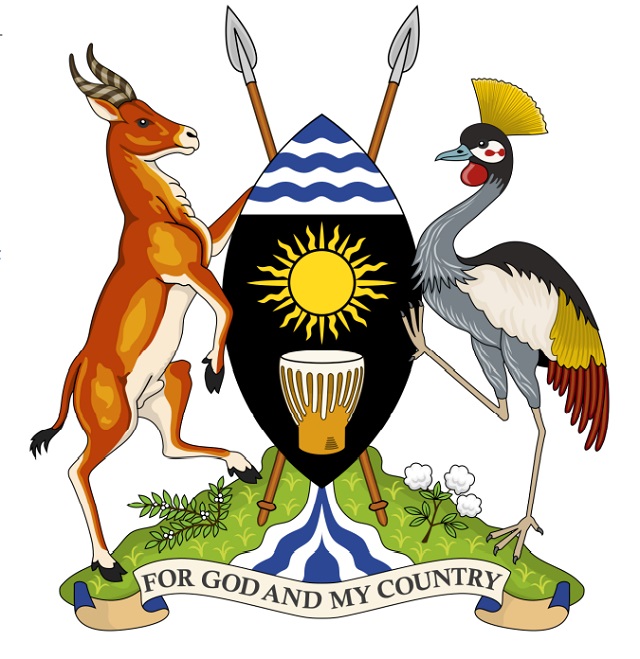
There have been distortions about the actual image of the national emblem and the symbolic meaning of some of the imagery which adorn the heraldic device
THE ARTS | DOMINIC MUWANGUZI | The Uganda Coat of Arms is a national emblem which adorns most government buildings including the Parliament, Judicial Chambers and State House; including all government ministries’ offices.
It is a representation of Uganda’s identity in various spectrum; natural beauty, diverse cultural heritage and, trust and belief in the supreme deity (God). Hence, the notable features on the emblem like the shield and spears are symbolic to the ability of citizens to protect and fight for their motherland, the green mound against which the spear and shield stand, represent fertile land ,and the Crested Crane and Ugandan Kob ( Kobus Kob thomasi) reflect the abundant wildlife in the country.
But there have been distortions about the actual image of the national emblem and the symbolic meaning of some of the imagery which adorn the heraldic device.
Unlike the original ensign measuring 130cm X120cm, created by Professor Cecil Todd of the then Margaret Trowell School of Fine Art, the one in circulation now, has a different colour scheme with notable differences on the drum and in the sun symbol.
The original drum had fingers like patterns running on the face of its belly and the sun had a semi concentric design embedded inside its pale yellow face. In this regard, the original emblem had a pale yellow sun and not a deep yellow, like is the case with what is showcased today.
Notable also is the difference in the type of blue used. Cecil Todd settled for a sky blue and did not use the ocean blue which pervades the emblem we are accustomed to.
Equally, critics point out that the message surrounding the drum as a symbol of royalty and the authority of Uganda Kings was deliberately altered by Milton Obote government in 1966 after he abolished monarchies in Uganda.
This happened after fraught relationships between himself and Buganda Kingdom. Before this saga, Kings and Chiefs in different Kingdoms were fully recognized under the constitution and enjoyed relative political autonomy.
In being dismissive to the legitimacy of monarchies, the new government may have also conspired to the reverse of some of the critical instruments which represent national identity. The national emblem, Coat of Arms, is one such device which certainly suffered this fate. With little doubt, the above highlighted distortions should have come into being during the latter regime.
Cecil Todd’s involvement with the production of the national emblem should not have happened accidentally. He was an art teacher and artist of extraordinary capabilities.
According to Dr.George Kyeyune, senior lecturer and art historian, at Margaret Trowell School of Industrial and Fineart, he says, Todd exhibited exceptional skills in art making.
“He was a draughtsman who specialized in anatomy,” Kyeyune reveals. Evident to the English man’s display of unique art skills, is the Barter and Exchange monument 1965 which adorns Tropical African Bank building, along Kampala Road.
The English don also created the Makerere University logo, almost akin to the Uganda national emblem. In all this, Todd not only showcased rare draughtsmanship skills, but was ultimately aware of the social cultural relevance his work inspired.
It seems obvious that while the colonial government was intent from the go to launch a new form of political infrastructure in the country, on the other hand, it did not necessarily want to stifle local dialogue on cultural identity and resonance. As such, the discernable delicate balance between West modernist art and African traditional imagery like drum, shield and spear in the painting.
There has been little attention paid to the exact location of the original national emblem, or if what we are often presented with is the original or replica.
This is probably because as one author put it, Uganda suffers from political amnesia; hence, it is quite easy to forget or ignore the immense significance and history of a political- cultural treasure like the Coat of Arms.
In all this, the conversation on building a national archive should come into mind. While the original ensign is stashed away among a huge collection of age old artworks in the Makerere Art gallery, it would be better if the artwork is exhibited in a permanent exhibition at the Uganda Museum or National gallery (Nomo gallery).
Here it can get its deserving attention from young and old, elite and non- elite, after all it’s a representation of Uganda’s unique national identity which will live on for many centuries.
****
 The Independent Uganda: You get the Truth we Pay the Price
The Independent Uganda: You get the Truth we Pay the Price


